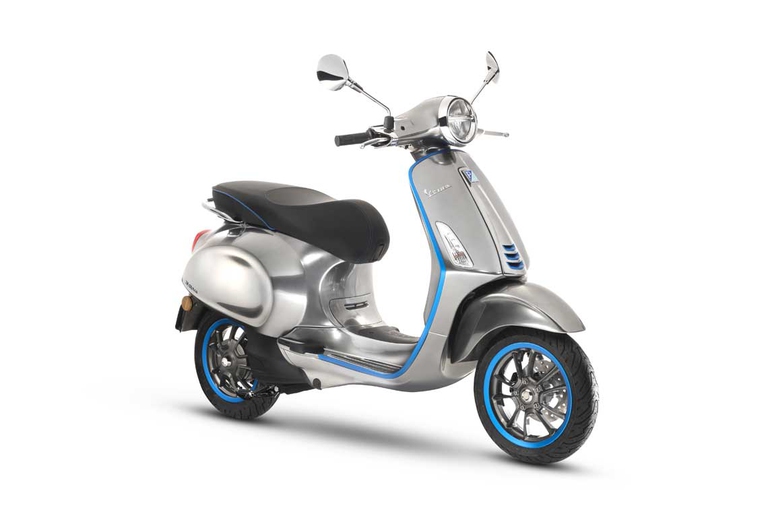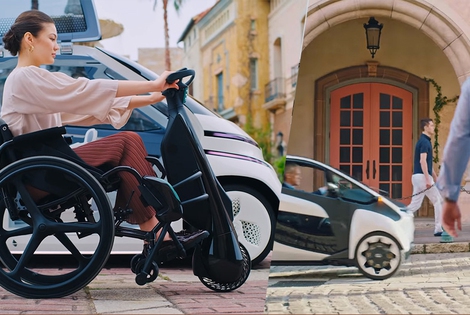
Milan has announced one of Europe’s most ambitious mobility schemes, known as Strade Aperte (open roads). Its goal is to reduce cars in phase 2 of the lockdown by increasing bike lanes and pedestrian areas.
The Vespa is back in an electric version. Production has just started and the first models can be reserved online starting from October.
The official announcement was made at the end of August. The Piaggio group has started production for the new electric Vespa, the long awaited zero emission model of the world’s most famous and beloved scooter. It is useless to say that the news has already travelled across the world and many fans are anxiously waiting for their chance to reserve a Vespa, starting from the beginning October, exclusively online. The price is 6,390 euros.
Electric Vespa will be produced in the historic Pontedera facility, in the province of Pisa, Italy, the same place where the legendary Vespa was born in 1946. Today, that same facility has become the symbol of technological advancement of the Piaggio group and the seat of future mobility solutions.
In the Fifties the Vespa was a pop icon, at the centre of many stories, journeys and adventures; now it’s back in an electric version with many new features, starting from the electric motor. The scooter’s new “heart” produces a maximum of 4kW, which means in practical terms that the scooter’s performance is slightly better than a traditional 50cc scooter. An added bonus is given by the acceleration and uphill push, typical features of electric motors.
Mostly designed for traffic in urban areas, the Electric Vespa has a 100 kilometre “fuel tank”, provided by a lithium ion battery and an efficient energy recovery system that recharges batteries during deceleration. The scooter can be recharged via a cable under the seat, (where the old fuel tank lid used to be) it can be connected to a normal electrical outlet or a charge station. A full recharge takes approximately four hours.
Read also: The Volkswagen van is back. It will be electric and self-driving
Piaggio ensures batteries will be fully efficient up to one thousand complete recharge cycles, i.e. a travelled distance between 70 and 90 thousand kilometres, the equivalent of more than ten years in a city. Beyond that, the battery still operates at 80 per cent of its capacity. A button on the handle allows you to choose between Eco and Power driving modes, whilst parking manoeuvres are made easier by a reverse gear.
A dedicated app will allow you to connect your Electric Vespa from your smartphone via Bluetooth (one of the available accessories is a helmet that integrates connection and headphones, this allows to answer phone calls with the buttons present on the handle and use the smartphone’s vocal commands. The remote key integrates the “bike finder” function, and a handy usb outlet can be found in the space under the seat. The Electric Vespa can be customised and has been presented in the chrome grey colour, and the first models will be available for reservation from the beginning of October, exclusively online, through a dedicated website, which is not yet available. Actual sales will start in November.
Siamo anche su WhatsApp. Segui il canale ufficiale LifeGate per restare aggiornata, aggiornato sulle ultime notizie e sulle nostre attività.
![]()
Quest'opera è distribuita con Licenza Creative Commons Attribuzione - Non commerciale - Non opere derivate 4.0 Internazionale.
Milan has announced one of Europe’s most ambitious mobility schemes, known as Strade Aperte (open roads). Its goal is to reduce cars in phase 2 of the lockdown by increasing bike lanes and pedestrian areas.
Formula 1, the world’s most important auto racing championship, has decided to turn the page and aim for carbon neutrality with the support of its teams, drivers and the whole racing circus.
Toyota and LifeGate began telling the story of hybrid mobility back in 2006, now, on the road to the Tokyo 2020 Olympics, they’re still treading the path of sustainable mobility. Here are the main steps of the journey.
Germany’s first solar bicycle lane could be the prototype for the roads of the future. The photovoltaic tiles melt snow and ice, and are capable of absorbing noise.
The city of Utrecht, in the Netherlands, is home to a bridge for cycling and walking that stretches over roof garden of a Montessori school. This project enhances practicality and will allow families to bring children to school by bike, passing through green areas. Despite their functionality, bridges are often seen as an infrastructure that is
The Lego hair bike helmet is the latest Internet craze. For now it’s just a prototype but production on a large scale will probably start soon.
Just as fires often give way to new growth, after the Dieselgate scandal, which saw Volkswagen cheating on US emission rules, the German car manufacturer radically changed course, beginning to focus on sustainable mobility. The German car company aims to propose thirty zero-emission models and produce at least one million battery electric vehicles by 2025. An ambitious mission
Sustainable, two-wheel mobility is triumphing in Copenhagen. After years of investments, policies, and infrastructural changes, bikes now outnumber cars in the city centre. The website Copenhagenize has released data linked to the number of vehicles entering the city centre, which are monitored by the city’s administration on a daily basis. Last year, 265,700 bikes have entered
A luminous cycling strip has recently been unveiled in Poland: created in the town of Lidzbark Warminski, the cycling lane glows blue at night, a feast for the eyes. Features of the bike path The lane is divided into two sections – one for cyclists, one for pedestrians – so that everybody can enjoy such









